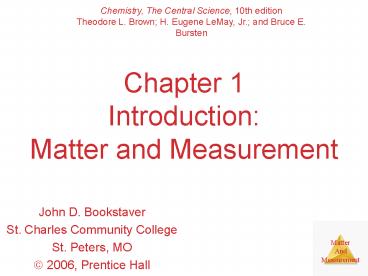Chapter 1 Introduction: Matter and Measurement - PowerPoint PPT Presentation
1 / 48
Title:
Chapter 1 Introduction: Matter and Measurement
Description:
Chemistry, The Central Science, 10th edition Theodore L. Brown; H. Eugene LeMay, Jr.; and Bruce E. Bursten Chapter 1 Introduction: Matter and Measurement – PowerPoint PPT presentation
Number of Views:610
Avg rating:3.0/5.0
Title: Chapter 1 Introduction: Matter and Measurement
1
Chapter 1IntroductionMatter and Measurement
Chemistry, The Central Science, 10th
edition Theodore L. Brown H. Eugene LeMay, Jr.
and Bruce E. Bursten
- John D. Bookstaver
- St. Charles Community College
- St. Peters, MO
- ? 2006, Prentice Hall
2
Chemistry
- The study of ________ and the ____________ it
undergoes.
3
Scientific Method
- A systematic approach to ____________ problems.
4
Matter
- Anything that has mass and takes up ____________.
5
Matter
- Atoms are the building blocks of ____________.
6
Matter
- Atoms are the building blocks of matter.
- Each element is made of the same kind of atom.
7
Matter
- Atoms are the building blocks of matter.
- Each element is made of the same kind of atom.
- A compound is made of two or more different
kinds of elements.
8
States of Matter
9
Classification of Matter
10
Classification of Matter
11
Classification of Matter
12
Classification of Matter
13
Classification of Matter
14
Classification of Matter
15
Classification of Matter
16
Classification of Matter
17
Classification of Matter
18
Classification of Matter
19
Mixtures and Compounds
20
Properties and Changes of Matter
21
Properties of Matter
- Physical Properties
- Can be observed ____________ changing a substance
into another substance. - Boiling point, density, mass, volume, etc.
- Chemical Properties
- Can only be observed when a substance is
____________ into another substance. - Flammability, corrosiveness, reactivity with
acid, etc.
22
Properties of Matter
- ____________ Properties
- Independent of the amount of the substance that
is present. - Density, boiling point, color, etc.
- ____________ Properties
- Dependent upon the amount of the substance
present. - Mass, volume, energy, etc.
23
Changes of Matter
- Physical Changes
- Changes in matter that do not change the
____________ of a substance. - Changes of state, temperature, volume, etc.
- Chemical Changes
- Changes that result in new ____________.
- Combustion, oxidation, decomposition, etc.
24
Chemical Reactions
- In the course of a chemical reaction, the
reacting substances are ____________ to new
substances.
25
Chemical Reactions
26
Compounds
- Compounds can be broken down into more
____________ particles.
27
Electrolysis of Water
28
Separation of Mixtures
29
Distillation
- Separates ____________ mixture on the basis of
differences in boiling point.
30
Distillation
31
Filtration
- Separates solid substances from ____________ and
solutions.
32
Chromatography
- Separates substances on the basis of differences
in ____________ in a solvent.
33
Units of Measurement
34
SI Units
- Système International dUnités
- Uses a different ____________ unit for each
quantity
35
Metric System
- ______ convert the base units into units that
are appropriate for the item being measured.
36
Volume
- The most commonly used metric units for volume
are the _____ (L) and the milliliter (mL). - A liter is a cube 1 dm long on each side.
- A milliliter is a cube 1 cm long on each side.
37
Uncertainty in Measurements
- Different measuring devices have different uses
and different ____________ of accuracy.
38
Temperature
- A measure of the ____________ ____________
____________ of the particles in a sample.
39
Temperature
- In scientific measurements, the Celsius and
____________ scales are most often used. - The Celsius scale is based on the properties of
water. - 0?C is the freezing point of water.
- 100?C is the boiling point of water.
40
Temperature
- The Kelvin is the SI unit of temperature.
- It is based on the ____________ of gases.
- There are no negative Kelvin temperatures.
- K ?C 273.15
41
Temperature
- The Fahrenheit scale is not used in scientific
measurements. - ?F 9/5(?C) 32
- ?C 5/9(?F - 32)
42
Density
- Physical property of a substance
43
Uncertainty in Measurement
44
Significant Figures
- The term ____________ figures refers to digits
that were measured. - When rounding calculated numbers, we pay
attention to significant figures so we do not
overstate the accuracy of our answers.
45
Significant Figures
- All ____________ digits are significant.
- Zeroes ____________ two significant figures are
themselves significant. - Zeroes at the ____________ of a number are never
significant. - Zeroes at the __________ of a number are
significant if a decimal point is written in the
number.
46
Significant Figures
- When addition or subtraction is performed,
answers are rounded to the least significant
____________ place. - When multiplication or division is performed,
answers are rounded to the number of digits that
corresponds to the least number of significant
figures in any of the numbers used in the
calculation.
47
Significant Digit Calculations
48
Accuracy versus Precision
- ____________ refers to the proximity of a
measurement to the true value of a quantity. - ____________ refers to the proximity of several
measurements to each other.































